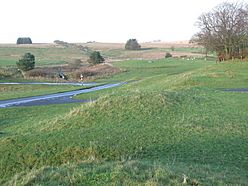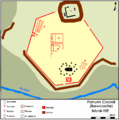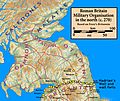Bewcastle Roman Fort facts for kids
Quick facts for kids Bewcastle Roman Fort |
|
|---|---|

Ramparts of the Roman fort at Bewcastle
|
|
| Known also as | Fanum Cocidi |
| Location | |
| Coordinates | 55°03′50″N 2°41′06″W / 55.064°N 2.685°W |
| County | Cumbria |
| Country | England |
| Reference | |
| UK-OSNG reference | NY563745 |
Bewcastle Roman Fort was an ancient Roman military base. It was built north of Hadrian's Wall in England. The Romans used it as an outpost to scout and gather information. Its Roman name was Fanum Cocidi. This means 'The Shrine of Cocidius'. Cocidius was a god worshipped in northern Britain. The fort's remains are in Bewcastle, Cumbria. It's about 7 miles (11 km) north of the Roman fort at Birdoswald. Nine altars were found here. Six of them were dedicated to Cocidius. This helped identify the fort's Roman name.
Contents
What Was Bewcastle Roman Fort?
This Roman fort was quite unusual. Most Roman forts were rectangular. But Bewcastle Fort was shaped like an irregular hexagon. It covered almost 6 acres (24,000 square meters) of land. The fort was built on a small, flat hilltop.
Connecting to Hadrian's Wall
Bewcastle Fort was linked to the fort at Birdoswald by a Roman road. This road was called the Maiden Way. Two stone signaling towers were found between the forts. These towers were at Barron’s Pike and Robin Hood’s Butts. Historians believe they were used to send messages from Bewcastle to Birdoswald.
How the Fort Was Built
The fort was likely built around the same time as Hadrian's Wall. At first, it had defenses made of turf (earth and grass). Its buildings were made of timber (wood). However, the main gates and the headquarters building were made of stone. Later, during the Antonine period, the turf walls were covered with stone. Eventually, the entire fort was rebuilt using only stone.
There were four main gateways: to the north, south, east, and west. The west gateway was the main entrance. The commander's house, called the praetorium, was near the center of the fort. The main headquarters, called the principia, was just north of the commander's house. A bathhouse, similar to those built during Hadrian's time, was located in the southeast part of the fort.
Who Built It?
Building inscriptions found at the site tell us which Roman army units helped build the fort. Parts of at least three different legions worked on it:
- The Second Legion, usually based in Caerleon in Wales.
- The Sixth Legion, based in York.
- The Twentieth Legion, based in Chester.
When Was the Fort Destroyed?
Bewcastle Fort was largely destroyed in A.D. 343. This happened when Hadrian's Wall was attacked and taken over. The fort was rebuilt after this attack. However, it was finally destroyed and abandoned after a major invasion by barbarian groups in A.D. 367.
Who Guarded the Fort?
The soldiers stationed at Bewcastle Fort were called the garrison.
- In the second century, the fort was guarded by the First Cohort of Dacians. This was a large infantry unit with about a thousand soldiers.
- In the third century, the First Cohors I Nerviorum is believed to have been the garrison. This unit included both infantry and cavalry (soldiers on horseback).
Exploring the Fort's Past
Limited archaeological digs happened at Bewcastle in 1937, 1954, and 1957. These excavations helped experts figure out where the buildings inside the fort were located. They also uncovered several altars dedicated to the god Cocidius.
Bewcastle Today
You can still see the earthworks and ditches of the fort today. A church and its churchyard now stand on the southern part of the site. The churchyard is also home to the famous Bewcastle Cross, an important historical monument.
To the northeast of the fort, you can find the remains of Bewcastle Castle. This was a Norman castle built around 1092. It was constructed using stones taken from the old Roman fort. Legend says the castle was destroyed by Oliver Cromwell in 1641.
Images for kids





